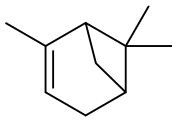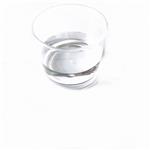Description
Alpha-pinene is the major constituent of turpentine
(about 80%). It exists as a levogyre form in European
turpentines, and as a dextrogyre form in turpentines
found in North America. Sensitization mainly occurs
in painters, polishers and varnishers, and in those in
the perfume and ceramics industry.
Chemical Properties
α-Pinene has a characteristic odor of pine. It is turpentine-like. The oxidized material has a resin-like odor.
Chemical Properties
liquid with a turpentine odour
Chemical Properties
α-Pinene is the most widespread pinene isomer. (+)-α-Pinene, (1R,5R)-2,6,6-trimethylbicyclo[3.3.1]hept-2-ene, occurs, for example, in oil from Pinus
palustris Mill., at a concentration up to 65%; oil from Pinus pinaster Soland and
American oil from Pinus caribaea contain 70% and 70–80%, respectively, of the
laevorotatory isomer, (?)-α-Pinene, (1S,5S)-2,6,6-trimethylbicyclo[3.3.1]hept-2-ene.
α-Pinene undergoes many reactions, of which the following are used in the fragrance
industry: upon hydrogenation, α-pinene is converted to pinane, which has
become an important starting material in the industrial processes used in the fragrance
and flavor industry. α-Pinene can be isomerized to β-pinene with high
selectivity for β-pinene formation. Hydration with simultaneous ring opening
yields terpineol and cis-terpin hydrate. Pyrolysis of α-pinene yields a mixture
of ocimene and alloocimene.
Pure α-pinene is obtained by distillation of turpentine oils. As a fragrance substance,
it is used to improve the odor of industrial products.However, it is farmore
important as a starting material in industrial syntheses, for example, terpineols, borneol, and camphor.
Occurrence
The structure would account for the presence of four optically active and two optically inactive isomers;
although only d-, l-, and dl-α-pinene are known, however; presence of one or more isomers has been reported in more than 400
essential oils; in the largest amounts it has been reported found in Achillea millefolium (d-), Artemisia tridentata (d-), Italian
rosemary (l-), wild thyme (l-), French lavender (l-), coriander (d-, dl-), cumin (d, dl-), labdanum (l-), neroli (l-), lemon, Litsea
cubeba (d-) and ylang-ylang (d-). It is also reported in over 200 natural products including apple, apricot, many citrus juices and
peel oils, bilberry, cranberry, lingonberry, blackberry, currants, guava, raspberry, strawberry, orange, lime, grapefruit, mandarin,
tangerine oils and juices, various spices, mint essential oils, carrot, celery, cooked potato, bell pepper, tomato, anise, cinnamon,
cassia leaf, clove, cumin, ginger, Mentha oils, nutmeg, mace, pepper, parsley, thyme, Swiss and cheddar cheese, cream, fatty fish,
fried chicken, beef fat, hop oil, rum, bourbon whiskey, tea, roasted filberts, pecans, oats, soybean, plum, mushroom, sweet and
wild marjoram, starfruit, mango, tamarind, cardamom, coriander, gin, rice, litchi, calamus, dill, lovage, caraway seed, buckwheat,
laurel, fennel, kiwifruit, myrtle leaf and berry, rosemary, buchu oil, Bourbon vanilla, Spanish and clary sage, nectarine, crayfish,
clam, cape gooseberry, anise hyssop, angelica root oil, Roman and German chamomile oil, eucalyptus oil, bullock’s heart and
mastic gum leaf and fruit oil.
Uses
Reference Standard in the analysis of herbal medicinal products
Uses
α-Pinene was used as standard in headspace solid-phase microextraction-gas chromatographic analysis of volatile compounds in virgin olive oils. It was used in the synthesis of cesium-doped heteropolyacid having potential application in biodiesel synthesis.
Definition
ChEBI: A pinene that is bicyclo[3.1.1]hept-2-ene substituted by methyl groups at positions 2, 6 and 6 respectively.
Production Methods
α-Pinene occurs naturally in a variety of trees and shrubs,
including more than 400 essential oils, and air concentrations
near pine forests may reach 500–1200 mg/m3. Total
U.S. emission of α-pinene from deciduous and coniferous
forests amounts to 6.6 million tons annually. An estimated
emission rate of α-pinene from natural sources to the
atmosphere is 1.84×10
-10 g/cm
3/s.
Preparation
From turpentine, by distillation.
Aroma threshold values
Detection: 2.5 to 62 ppb. Aroma characteristics at 1.0%: terpy citrus and spicy, woody pine and turpentinelike
with a slight cooling camphoraceous nutmeglike nuance, a fresh herbal lift and a tropical fruit top note.
Taste threshold values
Taste characteristics at 10 ppm: intense, woody, piney and terpy with camphoraceous and turpentine notes.
It has herbal, spicy and slightly tropical mango nuances.
General Description
A clear colorless liquid with a turpentine odor. Flash point 91°F. Less dense than water and insoluble in water. Vapors are heavier than air. Used as a solvent.
Air & Water Reactions
Highly flammable. Insoluble in water.
Reactivity Profile
alpha-Pinene may react vigorously with strong oxidizing agents. May react exothermically with reducing agents to release gaseous hydrogen.
Health Hazard
Harmful if swallowed, inhaled or absorbed through skin. High concentrations are extremely destructive to mucous membrane and upper respiratory tract, eyes and skin. Symptoms of exposure may include burning sensation, coughing, wheezing, laryngitis, shortness of breath, headache, nausea and vomiting.
Fire Hazard
Special Hazards of Combustion Products: Vapor may travel considerable distance to source of ignition and flashback. Container explosion may occur during fire conditions. Forms explosive mixtures in air.
Contact allergens
Alpha-pinene is the major constituent of turpentine
(about 80%). It exists in levogyre form in European
turpentine and in dextrogyre form in turpentine found
in North-Americans. Sensitization occurs mainly in
painters, polishers, and varnishers, and in those in the
perfume and in the ceramics industry.
Safety Profile
A deadly poison by
inhalation. Moderately toxic by ingestion.
An eye, mucous membrane, and severe
human skin irritant. Flammable liquid. A
dangerous fire hazard when exposed to heat,
flame, or oxidizing materials. To fight fire,
use foam, Co2, dry chemical. Explodes on
contact with nitrosyl perchlorate.
Toxics Screening Level
The ITSL for α-pinene is 1120 μg/m3 based on an 8-hour averaging time.







